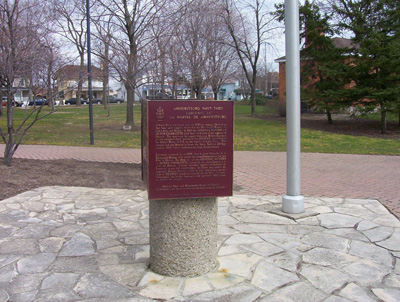Amherstburg Navy Yard National Historic Site of Canada
Amherstburg, Ontario

View of plaque
© Parks Canada Agency | Agence Parcs Canada, 2006.
Address :
Dalhousie Street, Amherstburg, Ontario
Recognition Statute:
Historic Sites and Monuments Act (R.S.C., 1985, c. H-4)
Designation Date:
1928-05-16
Event, Person, Organization:
-
British Royal Navy
(Builder)
Other Name(s):
-
Amherstburg Navy Yard
(Designation Name)
-
King's Navy Yard Park
(Other Name)
-
Amherstburg Navy Yard
(Plaque name)
-
Commissariat Building
(Name of contributing resources)
Research Report Number:
2009-CED/SDC-006
Plaque(s)
Original Plaque: Ontario
The British Naval station for Lakes Erie and Huron, 1796-1813. Here were built the King's ships Maria, Hope, Earl, Camden, General Hunter, Queen Charlotte, Lady Prevost, Chippewa, Little Belt and Detroit. In the war of 1812-14 this naval force enabled the army to retain control of this frontier.
Existing plaque: Water Works, Navy Yard Park Dalhousie Street, Amherstburg, Ontario
A Navy Yard was built here in 1796 to replace Detroit as the base and supply depot for the Provincial Marine on Lakes Erie and Huron. In 1812 the GENERAL HUNTER and QUEEN CHARLOTTE, built here, took part in the capture of Detroit. The next year, his supply lines cut, Robert Barclay’s poorly equipped fleet, including the DETROIT, was defeated by Oliver Perry, U.S.N., in the battle of Lake Erie. This reverse led the British to burn the Navy Yard on 22 September 1813, before withdrawing from Amherstburg.
Description of Historic Place
Amherstburg Navy Yard National Historic Site of Canada is a long, rectangular parcel of land overlooking the Detroit River in the town of Amherstburg, Ontario. This former British navy yard evacuated by the Royal Navy in 1813 contains no visible remains. Marked by a four-sided monument featuring four brass Historic Sites and Monuments Board of Canada plaques the site is now a 4.25 hectare (10.5 acre) municipal park that features a municipal cenotaph, and several buildings that either postdate the site or were moved to the site. The park features mature trees, formal gardens, walkways and metal railings at the edge of the river bank separating it from the river. Official recognition refers to the recreational area currently known as Navy Yard Park and the properties fronting Dalhousie Street.
Heritage Value
Amherstburg Navy Yard was designated a National Historic Site of Canada in 1928 because: the Navy Yard served as the British naval station for Lakes Erie and Huron, 1796-1813; in the War of 1812-14 the naval force built here enabled the army to retain control of this frontier.
Amherstburg Navy Yard was constructed in 1796 after British forces vacated Detroit and relocated downstream to the eastern side of the Detroit River. The yard, used to construct and repair vessels, served as the hub of the British Naval presence on the Upper Great Lakes. The yard’s facilities included a large storehouse, two blockhouses, a timber yard with a saw pit, and a wharf. To the north of the naval yard, the British built Fort Amherstburg, at what is now Fort Malden National Historic Site of Canada, and to the south, a settlement, which became known as Amherstburg, sprang up to supply the fort and naval yard. For almost 20 years, the yard produced vessels ranging from small, open bateaux, to full-sized, three-masted, ship-rigged men-of-war. Amherstburg Navy Yard played a significant defensive role during the War of 1812, as the ships it produced enabled the British to maintain control of the area.
Following the British defeat at the Battle of Lake Erie in 1813, Amherstburg was evacuated and both the fort and the navy yard were burnt prior to the American capture. The Americans later built an installation named Fort Malden on the ruins of Fort Amherstburg. Although Fort Malden was returned to the British in July 1815, the area never regained its pre-war importance as a fort and naval yard. The fort was used briefly during the rebellions of 1837-38 before its closure in 1858.
Sources: Historic Sites and Monuments Board of Canada, Minutes, 1928, 2009.
Character-Defining Elements
Key elements that contribute to the heritage character of the site include: its location within the limits of the town of Amherstburg and its proximity to Fort Malden National Historic Site of Canada; the siting overlooking the Detroit River, and its proximity to lakes Erie and Huron; the integrity of any surviving or as yet unidentified archaeological remains which may be found within the site in their original placement and extent.